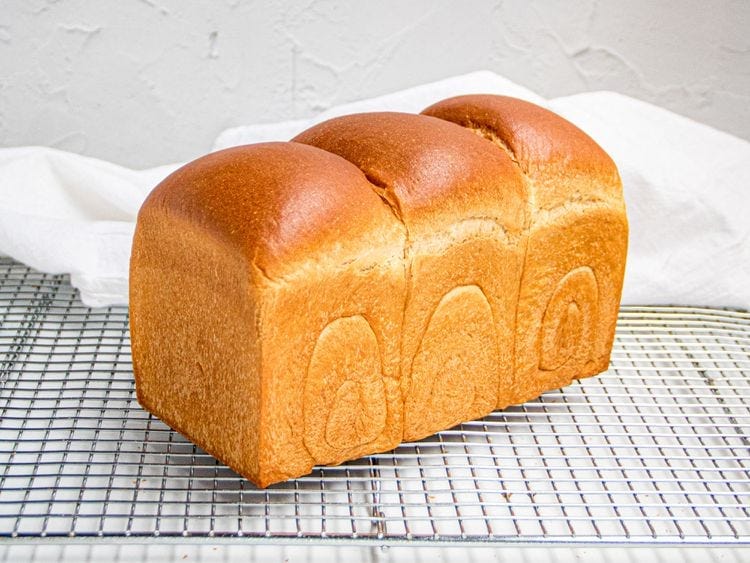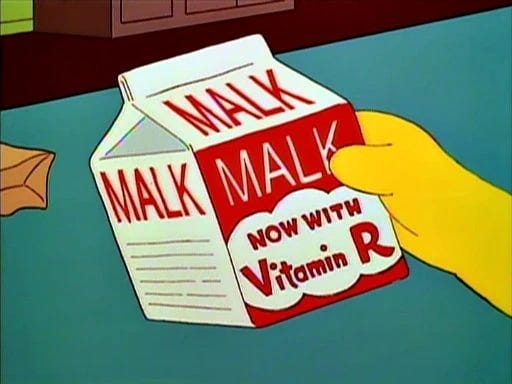Lifestyles of the Enriched and Famous, Part Two
On enriched breads and their ingredients—Milk and milk products

Table of Contents
This is post two in a multi-part series on the many ingredients that go into enriched breads. (The first post, on eggs, is here.) Today I’m covering milk and other liquid dairy products (butter I’ll mostly save for the next one, on fats.)
Milk and other dairy products
Whole milk is nearly 90% water; the remainder is made up of the sugar lactose (5%), proteins (3.3%), fat (3.3%, in the case of whole milk), and minerals (0.7%). The benefits of adding milk to breads are many:
- More intense browning of the crust, thanks to both milk proteins and sugars, which together undergo Maillard reactions.
- A finer, more even crumb, owing to the presence of proteins, emulsifying fats, and minerals, which help stabilize alveoli and limit gluten strength.
- A more tender crust, thanks to the proteins and the sugar lactose, which prevent the evaporation of water from the starch network.
- Slowed staling, for similar reasons.
The differences between whole, lowfat, and skim milk when used in breads are minimal, making them more-or-less interchangeable. Lowfat (2%) and skim (0%) milk contain less fat than whole milk, but because most enriched formulas also contain other fats like butter, it usually makes little difference which you choose. (This is why I simply call for "milk" in my recipes—you can use whatever you like.)
Because milk is 10% solids, when substituting milk for water, you’ll want to increase the amount of liquid you use by around 10%. (In other words, if a formula contains 75% water, you’d use 82.5% milk—75% x 1.1—to achieve a similar dough consistency.)
Nonfat milk powder
I really only buy milk to make yogurt, so when I am baking enriched breads, I typically use nonfat dry milk powder instead. It is shelf stable, which means I have "milk" on hand whenever I need it, and—aside from the missing fat, which I can get from other ingredients—it works identically to milk. (You can buy full fat milk powder too, but it is less common, and because of the fat, it’s far less shelf stable, so I never use it.) You don't have to "make" the milk before mixing the dough—you simply add the milk powder to the dry ingredients and add water to the dough. Milk powder is annoyingly slow to absorb water, so don’t do it the other way around, where you combine the milk powder with the liquid ingredients, or it will clump.
You'll want to use 10% milk powder and 90% water to replace the milk called for in a recipe; for example, if a formula calls for 300g milk, you'd use 30g milk powder and 270g water.
But, hot tip: Because milk powder is dry, you aren’t limited to using the equivalent of whatever liquid milk the formula might contain. You can instead add as much milk powder as you like, without all the water it would otherwise have. In other words, you can “super-enrich” the dough with milk solids, increasing the effects that milk provides beyond that which liquid milk can supply. I’m still working on a “super milk bread” formula for my book, so stay tuned for more intel on this approach, but if you try it, remember you’ll need to increase the amount of water you use to keep the dough of a similar consistency, since the milk powder is highly absorbent; a good starting point is probably around 1–2g of water for every 1g of additional milk powder used.
Brioche (a special case)
Brioche is usually made with high amounts of eggs and butter, and only small amounts of milk. In this case, I think it is fine (and simpler) to use water in place of milk. If your loaf only contains 50g of milk (for example), it’s only contributing about 5g of milk solids, which doesn’t amount to much. Leaving it out won’t make a noticeable difference, especially when you’ll have loads of milk solids coming from the butter instead. (Not to mention all the proteins provided by the eggs.)
On the other hand, if you use nonfat milk powder in your enriched breads, you can always “super-enrich” your formula with extra milk solids beyond which that small amount of milk would have contributed. You’ll of course need to increase the hydration to keep the dough texture consistent—a good starting point is an additional 1% water for every 1% nonfat dry milk powder used. (This is something I still need to play with—a “super milk bread” with say 20% nonfat milk powder instead of the 7% or so it normally contains.)
Heavy cream
Heavy cream is not used often in bread baking, but it actually makes for a great substitute for both butter and milk, since contains about 40% milk fat (i.e., butter), with the remainder being milk. To make the swap, divide the amount of butter called for in the recipe by 0.4 to determine how much cream to use. (For example, if the recipe contains 5% butter, use 12.4% heavy cream instead.) Then reduce the milk in the formula by the difference between these two numbers. (In other words, 12.4% heavy cream contains 5% butter plus 7.4% milk.)
Fermented milk products
Fermented milk products like yogurt, buttermilk, sour cream, crème fraîche, and kefir all contain similar compounds as milk, and will do similar things to a bread. But since they’ve been transformed by fermentation, they won’t necessarily perform identically.
Much of the lactose will have been consumed by the microbes, so browning will be reduced. And all of them supply acidity in the form of lactic acid, which can give the breads additional tang, but they’ll also increase gluten strength, so adjustments will need to be made in order to achieve a dough of a similar consistency to one made with milk. (The extra acidity will also decrease browning, since caramelization and Maillard reactions tend to happen faster in a basic environment.) In the case of yogurt, sour cream, crème fraîche, the structure of the proteins has also been altered by the fermentation, which means you’ll have to adjust the hydration to get the dough to flow similarly to one made with milk.
I don’t use fermented dairy often in breads, but if I did, I think buttermilk or kefir would be the simplest swaps, because they have a similar consistency to milk and the least amount of lactic acid. (Sour cream and crème fraîche are made from cream, of course, so those also supply butterfat, and are perhaps best thought of as a replacement for butter rather than milk.)
Vegan substitutes for milk products

As I mentioned last week, this is also something I am still working on (I’ll do a follow-up post eventually on vegan substitutes once I land on my preferences). But for now, I’ll say that I am skeptical about some of the choices that some recipe developers reach for.
That’s because while many vegan milks make for decent replacements for milk in beverages and cereal because they have a similar consistency and flavor (we use oat milk in our coffee, smoothies, and on granola at home), they don’t all contain the same types of compounds in milk. “Grain” milks like oat and nut milks are rich in starches, sugars, and fats (oat milk usually has added fat, in the form of oil), but they lack the protein that milk has (almond milk has about 1/10th the protein of milk, and oat milk only about 1/3 as much).
Starches, sugars, and fats all play important roles in breads, but those are all already supplied by other ingredients, and can be adjusted easily. Meanwhile, the protein in milk is one of its most important contributions to enriched breads, and none of these substitutes have nearly as much of it.
Soy milk, on the other hand, is made from beans, which are of course high in protein. As a result, soy milk has nearly as much protein in it as dairy milk (7g protein per cup versus 8g in milk). It’s also similarly rich in fat as whole milk, making it the ideal replacement, and the one I am most focused on right now. (I am aware that many people have allergies to soy, so I’m not sure how to address that. There are “pea” milks that might work just as well, though I don’t know if they are similarly problematic for those with soy allergies.)
Another fun thing about soy milk is that you can buy powdered soy milk (online, most easily, at least), so that you can use it just like nonfat milk powder, and even “super” enrich the dough in a similar way, if desired. I have a package of the stuff to play with soon…
Okay, that’s it for milk and milky products for now. What did I miss?
—Andrew
wordloaf Newsletter
Join the newsletter to receive the latest updates in your inbox.



